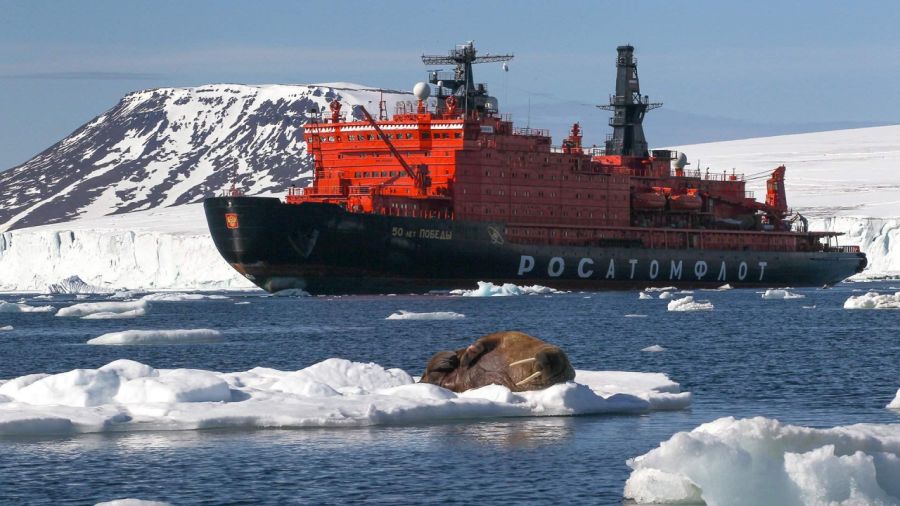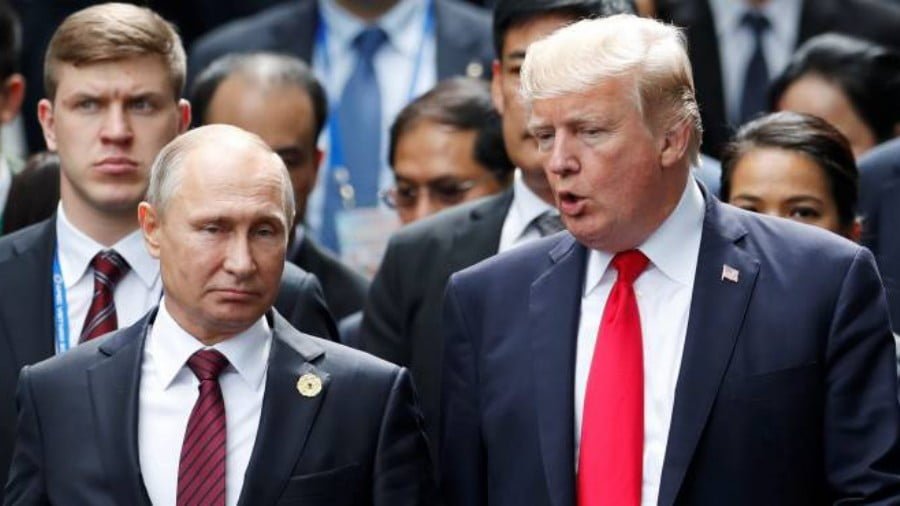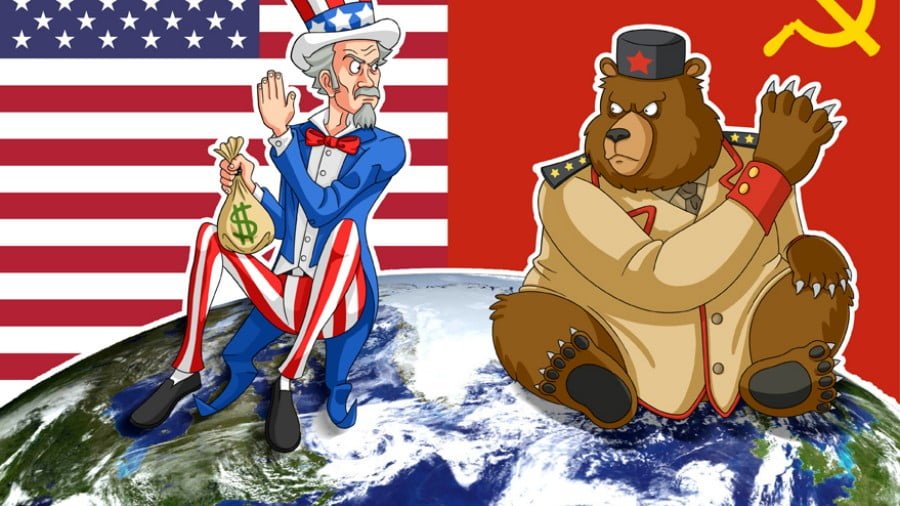The Battle for the Arctic Intensifies
The struggle for the Arctic may not be as obvious as for other spheres of geopolitical influence. Nevertheless, it is taking place and, with the EWS in Ukraine, Russia’s confrontation with other countries bordering the Arctic is only increasing. In most cases, Moscow’s sovereign stance spurs Western countries to militarise the region, and there are calls for greater control and access to resources. Not least are global security issues, as launching missiles from the North Pole area would allow for faster reaching the impact point and therefore greater chances of penetrating the enemy’s air defence system. During the Cold War era, the Arctic was used by both the USSR and the US as a potential nuclear launch area.
Conventional threats to the United States and NATO countries in the Arctic zone are therefore not being eliminated, but on the contrary, are becoming more relevant. Recently, Western analysts have been particularly concerned about Russia’s improved military capabilities. “The KH-101/102 missile, launched from submarines and widely used in Ukraine, has a range of 2,500 km… In their 2020 assessment of this threat, Generals Terrence J. O’Shaughnessy and Peter M. Fesler noted that the latest Russian submarines are now rehearsing these attacks with increased frequency and severity. In March 2021, the Russians openly sent a message by publishing images of submarines carrying nuclear-armed ballistic missiles surfacing through the Arctic ice north of Franz Josef Land… Even more unusual is the emergence of new state actors with an interest in the Arctic, especially in China. Although China’s navy has never sent warships to the Arctic Ocean, its rapid expansion and global ambitions have prompted the US to extrapolate a potential interest in the North. These concerns were voiced by then-Secretary of State Mike Pompeo at the 2019 Arctic Council meeting in Rovaniemi. Pence condemned China’s “aggressive behaviour” around the world, suggesting that Beijing might seek a military presence in the Arctic, highlighting the particular danger of PLA submarines operating under the ice cap. This assessment was supported by the US Department of Defense, which warned that the PLA may begin deploying ballistic missile submarines beneath the Arctic ice, within easy reach of Europe and North America, as confirmed by the US Navy’s 2021 Arctic Strategy.”[1]
There is talk of a possible transfer of hybrid warfare and grey area tactics to the Arctic region. This is partly attributed to the potential struggle for resources – both hydrocarbons and other minerals and marine bioresources.
Warming waters are attracting new fish to the north at the same time as a number of fish stocks are already depleted. Tracking and regulating fishing vessels engaged in illegal seafood harvesting is both legally and practically challenging. There is a practice of numerous vessels without transponders crossing the exclusive economic zone of various coastal states. And this pattern of behaviour takes on geopolitical significance. Interestingly, Canada waged this kind of hybrid warfare against Spain over stocks of turbot fish from 1994 to 1996, which turned into a bitter rivalry despite the fact that Canada and Spain are friends and allies in NATO. It cannot be ruled out that a similar scenario could play out in the Arctic. And the West is concerned that China, which although it has signed the 2018 Agreement on the Prevention of Unregulated Fishing in the High Seas of the Central Arctic Ocean, which bans commercial fishing until 2034, clearly understands that this agreement is a pathway to Arctic fisheries, not an outright ban, as many Western observers perceive it. The West is also concerned about scientific research by other countries, China for example. Over the past 20 years, China has conducted extensive marine scientific research in the Arctic Ocean and adjacent seas. China classifies this work as environmental research with purely scientific intentions. Despite this, AIS tracking of the Chinese icebreakers Xue Long and Xue Long 2 demonstrates a deep interest in resource mapping and deep seabed mining – with particular emphasis on the Northwind Ridge and the Chukchi Plateau on the US continental shelf. The Arctic states have already begun to pay attention to these activities. In 2021, Russia amended its claims to an extended continental shelf to include the Gakkel Ridge, just after China identified the area as the target of its Arctic expedition for the year. The US has also changed its rules on ship passage. Clearly, both Moscow and Washington perceive these Chinese icebreaking operations as more than just research. However, the West is constantly coordinating its actions on the subject of the High North and building new coalitions.
In autumn 2020, the United States, Canada, Denmark, Finland, New Zealand, Norway and Sweden signed a ground-breaking defence agreement: the International Cooperation Programme for Polar Research. The ICE-PPR is the first multilateral effort specifically focused on cooperation in high-latitude cold-weather regions around the world, and is a direct response to the increasing competition of the great powers in polar regions. ICE-PPR provides the full spectrum of research, development, testing, evaluation, experimentation, acquisition, deployment and personnel exchange. It is believed that if the United States takes full advantage of the agreement, it will lay the foundation for closing long-standing capability gaps in critical areas. Other ICE-PPR countries are continuously working in polar regions and investing in relevant capabilities. Finland has designed and is building a new ice-capable naval surface ship, New Zealand is launching a supply vessel capable of moving through ice, Canada is building an Arctic maritime patrol vessel, Canadian and Danish C-130 aircraft have delivered scientific payloads to the northern Arctic, and Canada has conducted an “Arctic Logistics” test exercise. The renewed focus on submarine warfare has also quietly intensified numerous efforts in Canada, Denmark, Norway, Sweden and Finland. The ICE-PPR also includes provisions for each country’s defense organizations to tap into the talents and expertise of their national scientific, national defense, and border security and environmental monitoring communities.[2]
Climate change is also linked to the Arctic. And the melting of ice in the Arctic is being reflected around the world. Environmentalists believe that in order to reduce the risks to the marine environment in the Arctic, it is necessary to limit the use of heavy fuel oil as fuel . Russia has considered banning the use of heavy fuel oil in the Arctic as a “measure of last resort”. The state-owned shipping company Sovcomflot has nevertheless openly stated the need to abandon petroleum-based fuel, while marine bunker fuel supplier Gazpromneft expects to stop using fuel oil from 2025. Notably, in August 2018, Russian President Vladimir Putin and Finnish President Sauli Niiniste made a joint statement on the need to switch to cleaner fuel for ships in the Arctic.[3]
However, ecology can also be used as a tool of political pressure or provocation, as was the case with the attack on the Prirazlomnaya platform by Greenpeace. Returning to the global assessment of the role of the Arctic, the Center for a New American Security in its analysis of possible Russian actions in the region directly links events in Ukraine and the West’s response to them. On this basis, the authors suggest that: – Contrary to Putin’s claims that Finland and Sweden’s membership in NATO poses no threat to Russia, their accession to the alliance would profoundly alter regional security dynamics, Moscow’s relationship with each country and, ultimately, Russian threat perceptions in the region. – The Kremlin’s sense of security will likely be affected by the relocation of any NATO infrastructure to Finland and Sweden, the increase in the scale and complexity of NATO exercises in the region, the concentration of air power on the Nordic peninsula, cross-border air exercises, increased intelligence gathering and the changed dynamics in the Baltic Sea, which will now be surrounded by NATO member states. This sense of Russian insecurity may increase the likelihood of miscalculation and escalation. – Russia’s war in Ukraine and the weakening of its conventional armed forces are likely to make the Russian political and military leadership see the increased utility of nuclear weapons in managing escalation and conflict, increasing the importance of the Kola Peninsula. – Russia’s growing sense of vulnerability, along with reduced channels of communication with the West, will likely lower the threshold for what the Kremlin responds to in the Arctic and likely increase the unpredictability of Russia’s actions there. Putin is also likely to see the Arctic as a place to demonstrate that Russia is still a power to be feared, increasing the risk of Russian provocations and miscalculations/escalations in the Arctic.[4]
At the same time, one possible scenario points to a rapprochement between Russia and China, which is now happening. At the same time, there are calls for the EU to pursue a more independent policy in the Arctic region. “Russia’s war against Ukraine also gives the EU regional reasons to further strengthen its economic ties with countries and regions in the North Atlantic – from Norway and the Faroe Islands to Iceland and Greenland and even the United States and Canada. Immediate security issues in which the EU can play a role are, for instance, the (critical) import of minerals or the use of Union satellite systems. In this way, the Arctic could become another example of the EU’s transformation from a technocratic regulator to a geopolitical actor willing to actively use its economic interdependencies, to confront its strategic dependencies – as analyzed in the context of the Industrial Strategy update – or to protect its member states from coercion by third parties.”[5]
The EU Arctic Strategy of 13 October 2021[6] states that “As a geopolitical force, the EU has strategic and everyday interests in both the European Arctic and the wider Arctic region. The EU also has a fundamental interest in supporting multilateral cooperation in the Arctic and in working to ensure that it remains safe, stable, sustainable, peaceful and prosperous. As a major economic actor, it shares responsibility for global sustainable development, including in the Arctic regions, and for the livelihoods of residents, including indigenous peoples. The EU has a significant impact on the Arctic through its impact on the environment and the demand for resources and products originating there”. At the same time it is said that “the increased interest in Arctic resources and transport routes may turn the region into an arena of local and geopolitical competition and possible tensions, possibly threatening EU interests”.
And further – “the EU’s full engagement in Arctic affairs is a geopolitical necessity. EU action should be based on its values and principles, including the rule of law, human rights, sustainable development, gender equality, diversity and inclusiveness, support for rule-based multilateralism and respect for international law, in particular the United Nations Convention on the Law of the Sea”. It also expresses caution over Russia’s strengthening of its military infrastructure in the Arctic and its dual use. There is also talk of increasing activity by other actors, including China, on critical infrastructure, sea cables, maritime issues, and cyber and disinformation (the latter is not entirely clear what the EU has in mind).
The EU has also created a post for an Arctic affairs representative, indicating that Brussels is becoming increasingly diplomatic in this area. It has also announced the opening of a European Commission office in Greenland to strengthen cooperation. In addition to the use of maritime infrastructure in the EU countries, the potential for connection to Russia’s Northern Sea Route is also mentioned.
“An extension of the corridor has been adopted as part of the Connecting Europe programme for 2021-2027 to transport goods originating from the Arctic regions by land and possibly through the Northern Sea Route,” the document said. Overall, the EU strategy is a balanced one. Putting aside the imperatives of EU values, the specific understanding of equality issues, as well as the vague rules of multilateralism, the overall approach leaves a framework for broad cooperation with stakeholders, including primarily Russia. While it is regretted that EU cooperation with Russia in the Arctic region has been suspended, it is hoped that the European Nordic countries can achieve their goals on a number of issues. These include the reduction of carbon dioxide emissions, the environmental agenda and energy security.
The US Arctic Strategy released in October 2022 is much more aggressive and unambiguous. [7] It acknowledges increased strategic competition in the Arctic since 2013, exacerbated by Russia’s conflict in Ukraine, and declares a desire to position the United States as a credible player both for effective competition and for managing tensions. To achieve this objective, Washington proposes four components: “Pillar 1 – Security: We will deter threats to the United States and our allies by building the capabilities necessary to protect our interests in the Arctic, while coordinating common approaches with allies and partners and reducing the risks of unintended escalation. We will implement a U.S. government presence in the Arctic region as necessary to protect the American people and our sovereign territory. Pillar 2 – Climate Change and Environmental Protection: The U.S. Government will work with Alaskan communities and the State of Alaska to build resilience to the impacts of climate change, working to reduce emissions from the Arctic as part of a broader global mitigation effort, to improve scientific understanding and preserve the Arctic ecosystem. Pillar 3 – Sustainable Economic Development: We will strive for sustainable development and improved living conditions in Alaska, including for Alaska Native communities, by investing in infrastructure, improving access to services and supporting growing economic sectors. We will also work with allies and partners to expand high-quality investment and sustainable development throughout the Arctic region. Pillar 4 – International Cooperation and Governance: Despite the challenges to Arctic cooperation posed by Russian aggression in Ukraine, the United States will work to support Arctic cooperation institutions, including the Arctic Council, and position these institutions to manage the impacts of increased activity in the region. We also seek to uphold international law, rules, norms and standards in the Arctic. Here again we see the famous ‘rules’ set by the US itself. If we study the document in more detail, we will find that the issues of economic interests and strategic deterrence are interlinked there. It states that “a more accessible Arctic would also create new economic opportunities… The growing strategic importance of the Arctic has intensified the competition to shape its future as countries pursue new economic interests and prepare to step up their activities.
It is true that opportunities are growing, but Russia controls most of the Arctic territories because of its long borders, and the Northern Sea Route runs through sovereign Russian waters. Oil and gas production is also active in Russia’s Arctic zone. Terminals for LNG, which is exported to other countries, are also being built. New icebreakers and research ships are being built, and Russia’s military infrastructure is being strengthened. The U.S. strategy has not overlooked this: “Over the past decade, Russia has significantly increased its military presence in the Arctic. It is modernising its military bases and airfields; deploying new coastal missile and air defence systems as well as modernised submarines; and stepping up military exercises and training operations with a new battle command. Russia is also developing new economic infrastructure in its Arctic territories to develop hydrocarbons, minerals and fisheries and is trying to limit freedom of navigation through its excessive maritime claims along the Northern Sea Route”.
It also says of China: “The People’s Republic of China seeks to strengthen its influence in the Arctic through an expanded list of economic, diplomatic, scientific and military activities. China has also stressed its intention to play a more active role in shaping regional governance. Over the past decade, the PRC has doubled its investment by focusing on the extraction of critical minerals; by expanding its scientific activities; and by using these scientific commitments to conduct dual-use research with intelligence or military applications in the Arctic. The PRC has expanded its icebreaker fleet and deployed naval vessels to the Arctic for the first time. Other non-Arctic countries have also increased their presence, investments and activities in the Arctic.
Strategic Objective 4.2: Protect Freedom of Navigation and Continental Shelf Limits is also of interest. It says that “The United States will protect the rights and freedoms of navigation and overflight over the Arctic and delineate the outer limits of the US continental shelf in accordance with international law as reflected in the United Nations Convention on the Law of the Sea. We will also continue to support accession to the Convention and vigorously defend U.S. interests, which are best served by universal respect for the international rule of law.”
The paradox is that under this Convention, the Northern Sea Route is entirely under Russian jurisdiction. It is understood as a historically unified national transportation route of the Russian Federation.
Navigation is carried out in accordance with special rules established by Russia under Article 234 of the Convention. Of course, foreign vessels may pass through the territorial seas of Russia, but they must be peaceful. And since the US and the whole NATO bloc are officially regarded as hostile states, any passage is out of the question. This is causing hysterical remarks from the American side. Earlier, in January 2021, the US Department of Defense released its own military strategy for the Arctic region, titled rather simply: “Restoring Dominance in the Arctic. [8] To do so, the US Army has developed some goals and plans that will allow it to “regain” dominance in the Arctic: – Establish a headquarters with specially trained and equipped combat brigades; – Improve the material preparedness of units able to operate in the Arctic; – Improve individual and collective training in mountain and high mountain environments; – Improve the quality of life of soldiers, civilians, and families living and working in the Arctic region; It is said that “in the new era of great power rivalry, the United States should be able to This demonstration of power by the air force, navy and armoured vehicles ensures that Russia and China will not interfere with navigation, sovereignty rights or the US ability to defend the homeland or project power from the Arctic region. The US Army has an important role to play in this region. The Army’s new Arctic strategy will enable it to restore its ability to defend US interests in the region”.
Note that this document was preceded by similar strategies issued under the US Air Force (June 2020)[9] and the Coast Guard (April 2019).[10] And in June 2019, the Pentagon sent a report to Congress justifying increased spending on Arctic needs and US geopolitical interests.[11]
The NATO Strategic Concept adopted at the Madrid Summit on 29 June 2022 states that “in the High North, its (Russia’s) ability to interfere with the strengthening of allies and freedom of navigation across the North Atlantic is a strategic challenge to the North Atlantic Alliance.”[12]
NATO also sees the Arctic region as an emerging global information hub, as communication cables also run through it. The Wall Street Journal writes that “Northern countries are seeking to lay submarine communication cables across Arctic waters as the shrinking ice cover opens up new business opportunities in the region and strengthens the geopolitical rivalry between Russia and the West. Planned cables by a group of Alaskan, Finnish and Japanese companies, as well as the Russian government, compete to build better digital infrastructure in a fragile but increasingly important area for defence and scientific research. Submarine cables via bundles of fibre-optic lines carry about 95 per cent of intercontinental voice and data traffic. There are currently more than 400 such cables, with signal delay roughly proportional to the length of each cable. Since the geographical distance between the continents in the Arctic is shorter the further south you go, a cable across the region would promise faster communications, experts say. The possibility of a route has become more feasible as accelerated warming has opened up the area for development.”[13]
For example, the Far North Fiber cable is expected to be operational from 2026.[14] In November 2022, a publication said that “the world’s largest satellite ground station in the Spitsbergen archipelago off the coast of Norway is being used by Western space agencies to collect vital signals from satellites in polar orbit. In January this year, one of two fibre-optic cables on the Arctic seabed linking Svalbard to the mainland was severed. Norway was forced to rely on backup communications.”[15] There were obvious allusions to Russia’s capabilities in the article. Although there was no precedent to qualify any Russian actions as such threats.
Finally, the battle for the Arctic also takes place on a discursive and ideological level. It is no accident that the term Euro-Arctic has recently emerged.[16] Just as the geopoliticians in the Federal Republic of Germany after the Second World War proposed the concept of a Euro-Africa (because possible eastward expansion, Drang nach Osten, was out of the question, for Germany itself was divided) to conduct a systematic expansion into that region, the two terms, Europe and the Arctic, have merged to denote some kind of unity at the conceptual level. It should be added that, in the West, there is a fair amount of scholarly attention to Arctic issues ranging from the cultural identity of autochthonous peoples to contemporary political issues.[17] This allows a strategic narrative to emerge that is used for political purposes.
To summarise, the Arctic strategies of many countries are coming into conflict, the collective West is trying to form its own alliance and sees Russia and China as potential threats. At the same time, the window of opportunity for cooperation remains, but cooperation requires political solutions, which are not being considered at the moment because of events in Ukraine. It remains for Russia to continue strengthening its military, technical and logistical capabilities in the High North, which is in line with the country’s geopolitical sovereign interests.
Note:
[1] Adam Lajeunesse. Arctic Perils: Emerging Threats in the Arctic Maritime Environment. November 2022. https://www.cgai.ca/arctic_perils_emerging_threats_in_the_arctic_maritime_environment
[2] Chris Bassler. Multi-National Cooperation Will Accelerate U.S. Defense Capabilities in the Polar Regions. December 15, 2020. https://csbaonline.org/about/news/multi-national-cooperation-will-accelerate-u.s-defense-capabilities-in-the-polar-regions
[3] Dave Walsh. Ridding the Arctic of the World ?s Dirtiest Fuel. February 19, 2019. https://www.pacificenvironment.org/ridding-the-arctic-of-the-worlds-dirtiest-fuel/
[4] Andrea Kendall-Taylor, Jim Townsend, Nicholas Lokker, Heli Hautala, Col James Frey, with contributions from Jim Danoy, Rebecca Pincus and Katarzyna Zysk. Russia in the Arctic: Gauging How Russia ?s Invasion of Ukraine Will Alter Regional Dynamics. SEPTEMBER 15, 2022. https://www.cnas.org/publications/reports/russia-in-the-arctic-gauging-how-russias-invasion-of-ukraine-will-alter-regional-dynamics
[5] Andreas Raspotnik and Andreas sthagen. The End of an Exceptional History: Re-Thinking the EU-Russia Arctic Relationship. Mar 23 2022. https://www.e-ir.info/2022/03/23/the-end-of-an-exceptional-history-re-thinking-the-eu-russia-arctic-relationship/
[6] https://www.eeas.europa.eu/sites/default/files/2_en_act_part1_v7.pdf
[7] https://www.whitehouse.gov/wp-content/uploads/2022/10/National-Strategy-for-the-Arctic-Region.pdf
[8] https://sof.news/defense/army-arctic-strategy-2021/
[9] https://www.af.mil/Portals/1/documents/2020SAF/July/ArcticStrategy.pdf
[10] https://www.uscg.mil/Portals/0/Images/arctic/Arctic_Strategic_Outlook_APR_2019.pdf
[11] https://media.defense.gov/2019/Jun/06/2002141657/-1/-1/1/2019-DOD-ARCTIC-STRATEGY.PDF
[12] https://www.nato.int/nato_static_fl2014/assets/pdf/2022/6/pdf/290622-strategic-concept.pdf
[13] Isabelle Bousquette. A Warming Arctic Emerges as a Route for Subsea Cables. WSJ/CIO Journal, June 15, 2022. https://www.wsj.com/articles/a-warming-arctic-emerges-as-a-route-for-subsea-cables-11655323903
[14] Nima Khorrami. A Looming Cable Race in the Arctic: What Role for NATO? September 21, 2022 https://www.wilsoncenter.org/article/looming-cable-race-arctic-what-role-nato; Colin Wall, Pierre Morcos. Invisible and Vital: Undersea Cables and Transatlantic Security. June 11, 2021. https://www.csis.org/analysis/invisible-and-vital-undersea-cables-and-transatlantic-security
[15] Jacob Gronholt-pedersen, Gwladys Fouche. NATO allies wake up to Russian supremacy in the Arctic. November 16, 2022. https://www.reuters.com/world/europe/nato-allies-wake-up-russian-supremacy-arctic-2022-11-16/
[16] Iris Thatcher. The EU and the Future of Arctic Cooperation in the Northern Dimension. September 7, 2022. https://www.wilsoncenter.org/blog-post/no-14-eu-and-future-arctic-cooperation-northern-dimension
[17] https://thenorthernreview.ca/nr/index.php/nr/index







